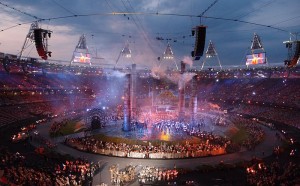Danny Boyle's postindustrial pageant: Mission impossible, yet laudable
02 August 2012 – Cathy Stanton

Smoke, light, and hundreds of amateur performers re-create “The Age of Industry” in the July 27 2012 Olympics opening ceremony in London.
The Olympic opening ceremony last Friday, staged by filmmaker Danny Boyle, left me with a strange feeling of déja vu. All the high-tech elements aside, this show could have been produced in 1912 almost as easily as 2012. Its capsule-history-of-Great-Britain-from-green-and-pleasant-land-through-industrial-power-to-postindustrial-success format essentially followed the pageant form that was popular a hundred years ago.[1] Heavy emphasis on youth, cultural continuity, and the contributions of many groups to a cohesive whole—check. Cast of thousands of amateur performers, some of whom (including, in this case, real-life doctors and nurses from the National Health Service) were performing as themselves—check. References to key cultural icons—check, check, and check again (Shakespeare… Voldemort… The Sex Pistols… James Bond… Paul McCartney… Corgis… the list went on and on).
Looking at photos of early 20th century pageants, especially the larger-scale ones, has always made me think it was probably more fun to be a performer than a spectator at those events, and the Olympic ceremonies gave me the same feeling.[2] That was something NBC hosts Meredith Viera and Matt Lauer kept commenting on, too–“Imagine what it’s like for those doctors and nurses to be in the midst of this” and “Think how excited those kids must be.” At least in the early segments (I confess I didn’t sit through the nearly four hours to the end), there weren’t many things that worked well at the level of both detail and spectacle, even with an army of television cameras to help with the close-ups. But it seemed as though the “realness” of the massed amateur performers perhaps filled in some of the gaps, providing some “heart” of the kind that sports coverage is so often built around and that isn’t entirely gone from the Olympic ideal despite the hyped-up, locked-down nature of the contemporary Games. Ordinary people performing their own history, while being a part of a historic moment at the same time–it was hokey in an oddly endearing way.
I seem to be immune to the charms of stylized production numbers, so I can’t say that the opening ceremony worked for me on either an emotional or aesthetic level. But I can’t quite dismiss the event, either. Boyle can perhaps be criticized for trying to incorporate far too many disparate pieces, but his trying to hold open a space for a kind of participatory performance deserves recognition. Maybe there was no fully convincing way to combine amateur pageantry with hyper-mediatized global spectacle, but there was surely something laudably ambitious in making the attempt.
~ Cathy Stanton, Tufts University
[1] The heyday of American pageantry is explored in David Glassberg’s classic study American Historical Pageantry: The Uses of Tradition in the Early Twentieth Century (University of North Carolina Press, 1990).
[2] I couldn’t find a lot of good images of these online, but here’s a photo of the pageant cast from Albion, Michigan’s 1935 centennial, and another one from the Mormon Tabernacle’s centennial in 1930. Glassberg’s book is filled with wonderful pictures of large- and small-scale pageants of all kinds.




Great post! I’ve always found historical pageants fascinating. There’s actually a wonderful set of photos in the archives of the Jersey City Museum depicting a Bergen County historical celebration in 1910. The photos are shrouded in mystery, because they came from an unknown donor and there are no records of the photo studio that produced them. The mystery adds to the fun: http://www.jerseycitymuseum.org/imgdtl.cfm?imageid=151&cid=33
This is a great example of the form, Adina. I bet there are many more of these sets of photos that haven’t been digitized or made available online yet. This was such a ubiquitous performance genre, and widely recorded.
One of the things that’s interesting to me about it is that when you do a Google search for “historical pageant city” or something similar now, the Olympic ceremony turns up frequently in the results. Seems to indicate that the continuities I was seeing are reflected in Google’s algorithms too!